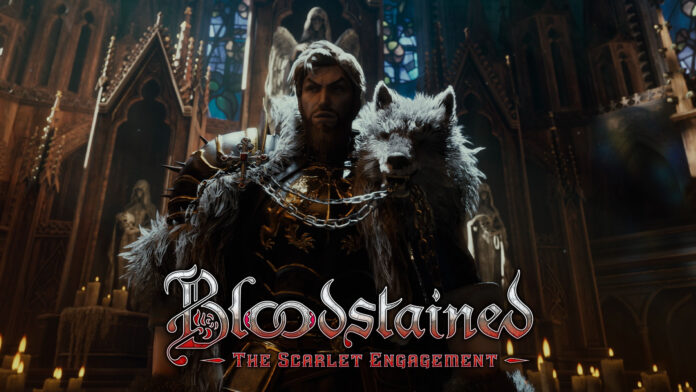The text below was published on Epic Games’ official site.
Among the highly anticipated sequels, Bloodstained: The Scarlet Engagement stands out not just for the excitement surrounding the game, but for its surprisingly long development journey. The follow-up to Bloodstained: Ritual of the Night (one of the most successful crowdfunding campaigns in history) quietly began development in 2021. A prequel featuring a new setting, new heroes, and a completely fresh gameplay approach, Bloodstained: The Scarlet Engagement is a transformative return to the IGAvania genre.
This interview marks the first detailed look at Bloodstained: The Scarlet Engagement since the game’s recent announcement. We met with Kōji Igarashi (better known as IGA), producer of Bloodstained: Ritual of the Night and the legendary Castlevania series, along with Creative Director Shūtarō Īda (also known as SHUTARO), who handled everything from planning to scenario writing for Bloodstained: The Scarlet Engagement. Together, they showcased the meticulous attention to detail and deep dedication embedded in the project.
Q: Can you play as Leo with Alex, Alex with Leo, or solo? Are there significant differences depending on which character you directly control? And are there advantages to playing solo with just one character instead of using both?
SHUTARO: I’ll answer this. First, there’s not a huge difference in how you control the two characters. However, Leo is slightly better with magic, while Alex specializes in physical strength. There are some differences in their magical abilities, but nothing drastic.
A key feature we’re implementing in Bloodstained: The Scarlet Engagement is the “class system.” Through this system, we want players to express their individuality and unique playstyles, and development is progressing to support this.
Regarding solo play, you control either Leo or Alex while the other character is AI-controlled. Generally, having both characters on-screen simultaneously provides an advantage in most situations. However, some battles require focusing on just one character to dodge or defend against certain attacks or situations, so strategic solo play may sometimes be the better choice.
Q: When controlling Leo and Alex, is the system based on swapping between them by pressing a button? Or is there some multiplayer element involved?
SHUTARO: Yes, players can swap between both characters at will. Even during solo play, you can use your “partner” to cast spells or perform combos with a command. For example, if controlling Leo with Alex under AI control, you can still instruct Alex when to cast spells.

Q: Wow, that sounds really cool! Since this game is set in the past, does that mean it takes place before Miriam’s story in Bloodstained: Ritual of the Night? And why did you decide to use two playable characters this time instead of focusing on one protagonist?
SHUTARO: The game doesn’t have much to do with Miriam, but it has deep connections to the previous title, Bloodstained: Ritual of the Night. As we delved deeper into the previous game’s lore, these two characters naturally emerged as the perfect choice for this new story… though I’m being intentionally a bit vague now.
IGA: Yes, that’s right.
SHUTARO: There is a deep connection between the two characters and a certain important character from Bloodstained: Ritual of the Night.
Q: From a developer perspective, what are some key points you focused on to keep the game current and appealing?
SHUTARO: In Bloodstained: The Scarlet Engagement, we heavily emphasize story in the first half, but as players progress into the second half, they gain much more freedom.

Q: That’s definitely something we want to see! For Bloodstained: Ritual of the Night, you likely received significant community feedback. What types of feedback did you find most useful or impactful in shaping Bloodstained: The Scarlet Engagement?
SHUTARO: Ever since we worked on the Castlevania series, we’ve consistently received the same feedback: people wanted more story elements and deeper character development. It was always the most common request. And I kept telling IGA, “Work harder on the story,” but he’d usually say, “I want to keep story minimal.” So I gave up in the past and ended up writing Castlevania: Curse of Darkness‘s story. This time too, I decided, “I’ll handle this!”
Q: In Bloodstained: Ritual of the Night, customization was already an important part of gameplay, but it seems Bloodstained: The Scarlet Engagement takes it further. Do Leo and Alex each have their own customization item sets? Or do they share an inventory?
SHUTARO: Broadly speaking, items in the inventory are shared between both characters.
Q: Speaking of customization, will all equipped items be reflected in the character’s appearance? In Bloodstained: Ritual of the Night, that was part of the fun. Will this feature return in Bloodstained: The Scarlet Engagement?
SHUTARO: Yes, we have various customizable equipment items, including parts like pants, boots, helmets, capes, and even accessories like glasses. All these contribute to visual customization by changing the characters’ appearance.

Q: How does overall character speed and movement feel compared to the previous title? Is the pacing similar, or were changes made to make it faster or slower?
SHUTARO: Around the mid-game, you might notice movement speed gets slightly faster. This time, we have multiple equipment items that boost speed for pants, along with functions that increase movement speed. As players progress, their movement speed gradually increases, so pacing tends to accelerate in the later stages.
Q: The previous title, Bloodstained: Ritual of the Night, was only possible through crowdfunding and included various stretch goals, leading to a relatively long development cycle. When exactly did development begin for this new sequel, Bloodstained: The Scarlet Engagement?
IGA: I’ll answer. The project officially started in July 2021, but it was mid-2023 when we restructured the team and organized the internal development framework that full-scale development truly began.
SHUTARO: Exactly. Actually, Bloodstained: The Scarlet Engagement‘s planning phase was completed quite some time ago.

Q: But the game isn’t finished yet, right? I heard the release is set for 2026.
IGA: No, it’s not finished yet. There’s still time until release.
Q: Bloodstained: Ritual of the Night‘s crowdfunding campaign was a huge success, reaching multiple stretch goals, but I believe this brought both advantages and disadvantages. While it certainly brought significant funding for development, it also meant the team had to continuously create content for fans. In the current title, these constraints don’t exist, suggesting more creative freedom. Is that accurate?
SHUTARO: Absolutely, it was thanks to our fans’ support and expectations that we completed the previous game, and that support remains a crucial driving force. However, this time we have more flexibility to adjust the project scope as needed. Since we haven’t officially announced much yet, there are no strict “mandatory” requirements tied to public commitments.
This flexibility isn’t always beneficial though. I often start projects with ambitious ideas and goals, but as schedules tighten, the team sometimes points out certain things might be impossible to include within the timeframe. So, considering budget and schedule, we end up needing to cut some scope.
Thus, this project gives us even more freedom to adjust or scrap initial plans—in fact, we’ve already removed some ideas.

Q: I’d like to ask about future plans for Bloodstained: The Scarlet Engagement. Have you planned future expansions like DLCs or crossovers? Or is the current title intended as a fully standalone story with a complete ending?
IGA: Currently, we’re not ready to announce anything, but we hope fans look forward to future updates.
Q: I heard Bloodstained: The Scarlet Engagement has a day-night cycle. How long is each period? For example, does daytime last about 15 minutes and night the same?
SHUTARO: Exactly. Currently, a full day-night cycle representing 24 hours lasts about 30 minutes total. However, we think some adjustments may be needed going forward.
Q: Is the passage of time indicated by background visual changes or something similar?
SHUTARO: Yes, definitely. Time progression is clearly indicated through changes in the scenery and lighting, making it easy to notice.

Q: The class system seems interesting. From my perspective, it appears to strengthen RPG elements even further. Can you tell us more about how this system functions?
SHUTARO: You can choose from over 10 different classes and level each up as you play. Leveling up allows you to learn new abilities and talents. Also, some spells and abilities can only be learned in specific classes. Skills learned in one class can be transferred to others if certain conditions are met, making players stronger as they progress.
For example, you might start mastering the Fighter class, then learn the Ninja class. Skills acquired as a Fighter can also be used while playing as a Ninja.
We really hope players make the most of this system.
Q: Is the level cap 99, same as the previous game Bloodstained: Ritual of the Night?
SHUTARO: Yes, currently the level cap is set at 99.
Q: So does that mean if you level all classes to 99, your character becomes invincible?
SHUTARO: Yes, exactly. The player has two separate levels: one common level and one class level. The class level increases slightly faster than the common level.

Q: Could you also explain the “Epiphany” combat system?
SHUTARO: This is a system where you can gain “inspiration” for new abilities during combat by meeting certain conditions. For example, if using a specific weapon with attributes above a certain threshold, attacking an enemy under these conditions may trigger a moment of inspiration, allowing your character to learn a new technique on the spot—which can then be freely used afterward.
Q: The previous title, Bloodstained: Ritual of the Night, had crafting and cooking systems, but I heard they’ve been enhanced in Bloodstained: The Scarlet Engagement. Did you introduce a completely new system, or is it more of an improvement—like a significant increase in recipes?
SHUTARO: In the previous game, if you lacked materials for cooking or crafting, you had to go to the shop to acquire them. Now, if required materials are available in the shop, you can buy them directly from the crafting screen and continue crafting immediately.
Q: Does that mean players no longer need to collect items from specific enemies or monsters?
SHUTARO: No, that element remains. If a needed material is shop-available, you can buy it directly from the crafting screen. However, if it’s not in stock, you’ll still need to gather it from enemies.

Q: Regarding crafting, in the previous game Bloodstained: Ritual of the Night, we used Shards. Each monster had its own Shard, which players used to craft items before enhancing them from +1 to +10. However, you needed to continuously gather Shards for leveling. Is the system similar in Bloodstained: The Scarlet Engagement?
SHUTARO: We no longer have Shards, so the system isn’t the same as the previous game. But crafting still involves major differences. Even weak weapons can be upgraded into more powerful, high-performance ones through crafting—for example, a basic dagger can become a much stronger blade depending on how you craft it.
Q: There’s a new feature referencing “Base” and “Base Furniture.” Is this “Base” like your home or save room? And can you furnish and customize the space?
SHUTARO: Yes, the save room is part of your Base. But the Base itself is a much larger area beyond the save room. Within it, you’ll have your own space where you can decorate with furniture.
Q: Are furniture items mainly purchased in shops, or can they also be found during gameplay?
SHUTARO: There are various ways to obtain furniture. You can buy them in shops, craft them, or find them during your journey. Once you have furniture, you can place it in your Base.
Q: Can players arrange furniture freely, or is it placed automatically upon collection? Put another way—if a player collects all furniture and completes the collection, will everyone end up with identical spaces, or can they place items wherever they want?
SHUTARO: Originally, we wanted players to place furniture freely as they wished. However, due to development constraints, we had to cut this feature. Therefore, furniture can now only be placed in predetermined spots.
Q: You’ve collaborated on several games, consistently delivering high-quality titles within a genre sometimes called “IGAvania.” What keeps you anchored to this genre, and what do you do to keep creating games that feel current, fun, and addictive every time?
SHUTARO: I always try to innovate the scene. You could say I’m more of a reformist, and I’ve been fortunate to have the freedom for this approach.
IGA: On the other hand, I’m not much of a reformist. Sometimes I ask, “Can we keep this part as-is…?”
SHUTARO: …But I also don’t want to stay in the comfort zone. And there’s a reason. No matter how many new things we try, ultimately the game still fits the Metroidvania genre. That’s why I believe we must continue introducing fresh ideas. I always change characters and am unafraid to revise entire systems. It’s like saying, “This time, let’s make a two-player game!” or “Let’s implement a Glyph system!”
For context: the first Nintendo DS title was planned by IGA-san, so it felt like a direct evolution of the previous game. But the second and third were planned by me, and I think you can see major changes there.
For this new title, I was greenlit to push boundaries again… so I think it’ll be a very exciting game.
Q: Lastly, could you share a message for fans? We’d love to hear something from each of you. There’s a lot of excitement and anticipation out there.
SHUTARO: Look… honestly, this game feels quite “different” from anything we’ve done before. The graphics are improved, and though we’ve done co-op modes before, now you can actually play with two players simultaneously—a significant new feature.
I think it’s somewhat different from the previous game, so I hope it sparks everyone’s interest.
Additionally, story and cutscenes have been enhanced since last time. We made sure to reinforce areas people felt were lacking before, so I hope you enjoy it.
IGA: Once again, I’m partnering with SHUTARO on this project. Every title he’s been involved with has received excellent feedback.
Since he’s deeply involved as creative director this time, I’m confident this game will be even more enjoyable than the last. You can look forward to it.




